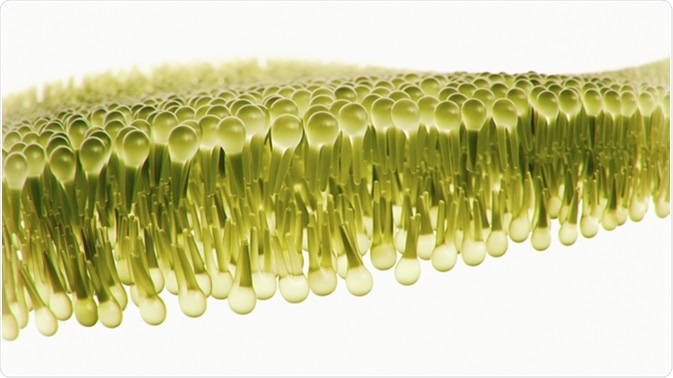What are Lipids? / लिपिड क्या हैं?
(1) Lipids are monosaccharides / लिपिड मोनोसैकेराइड हैं
(2) Lipids do not provide energy to cells / लिपिड कोशिकाओं को ऊर्जा प्रदान नहीं करते हैं
(3) Fruits are a good source of lipids / फल लिपिड के अच्छे स्रोत हैं
(4) Cholesterol and trans fatty acids are types of Lipids / कोलेस्ट्रॉल और ट्रांस फैटी एसिड लिपिड के प्रकार हैं
(SSC CPO SI, ASI Online Exam. 05.06.2016)
Answer / उत्तर :-
(4) Cholesterol and trans fatty acids are types of Lipids / कोलेस्ट्रॉल और ट्रांस फैटी एसिड लिपिड के प्रकार हैं

Explanation / व्याख्या :-
लिपिड प्राकृतिक रूप से पाए जाने वाले अणुओं का एक समूह है जिसमें वसा, मोम, स्टेरोल, वसा में घुलनशील विटामिन (जैसे विटामिन ए, डी, ई, और के), मोनोग्लिसराइड्स, डाइग्लिसराइड्स, ट्राइग्लिसराइड्स, फॉस्फोलिपिड्स और अन्य शामिल हैं। वे फैटी एसिड और उनके डेरिवेटिव (त्रि-, डी-, मोनोग्लिसराइड्स, और फॉस्फोलिपिड्स सहित) जैसे अणुओं को शामिल करते हैं, साथ ही साथ कोलेस्ट्रॉल जैसे अन्य स्टेरोल युक्त मेटाबोलाइट्स।
लिपिड क्या है?
एक लिपिड एक वसा घुलनशील अणु है। इसे एक और तरीके से रखने के लिए, लिपिड पानी में अघुलनशील होते हैं लेकिन कम से कम एक कार्बनिक विलायक में घुलनशील होते हैं।
जैविक यौगिकों ( न्यूक्लिक एसिड , प्रोटीन, और कार्बोहाइड्रेट) के अन्य प्रमुख वर्ग कार्बनिक विलायक की तुलना में पानी में अधिक घुलनशील होते हैं। लिपिड हाइड्रोकार्बन (अणुओं में हाइड्रोजन और ऑक्सीजन होते हैं) होते हैं, लेकिन वे एक आम अणु संरचना साझा नहीं करते हैं।
लिपिड जिसमें एस्टर कार्यात्मक समूह होता है, पानी में हाइड्रोलाइज्ड हो सकता है। वैक्स, ग्लाइकोलिपिड्स, फॉस्फोलाइपिड्स, और तटस्थ मोम हाइड्रोलाइजेबल लिपिड हैं। इस कार्यात्मक समूह की कमी वाले लिपिड्स को गैरहाइड्रोलिजेबल माना जाता है। Nonhydrolyzable लिपिड स्टेरॉयड और वसा घुलनशील विटामिन ए, डी, ई, और के शामिल हैं।
सामान्य लिपिड के उदाहरण
लिपिड्स के कई अलग-अलग प्रकार हैं। सामान्य लिपिड के उदाहरणों में मक्खन, वनस्पति तेल , कोलेस्ट्रॉल और अन्य स्टेरॉयड, वैक्स , फॉस्फोलाइपिड्स, और वसा-घुलनशील विटामिन शामिल हैं। इन सभी यौगिकों की सामान्य विशेषता यह है कि वे अनिवार्य रूप से एक या अधिक कार्बनिक सॉल्वैंट्स में घुलनशील पानी में अघुलनशील होते हैं।
लिपिड्स के कार्य क्या हैं?
लिपिड्स का उपयोग ऊर्जा भंडारण के लिए जीवों द्वारा किया जाता है, एक सिग्नलिंग अणु (उदाहरण के लिए, स्टेरॉयड हार्मोन ), इंट्रासेल्यूलर मैसेंजर के रूप में, और सेल झिल्ली के संरचनात्मक घटक के रूप में। कुछ प्रकार के लिपिड आहार से प्राप्त किए जाने चाहिए, जबकि अन्य शरीर के भीतर संश्लेषित किया जा सकता है।
लिपिड संरचना
यद्यपि लिपिड्स के लिए कोई भी सामान्य संरचना नहीं है, लिपिड्स की सबसे आम श्रेणी ट्राइग्लिसराइड्स होती है, जो वसा और तेल होते हैं। ट्राइगिलराइड्स में एक ग्लिसरॉल रीढ़ की हड्डी होती है जो तीन फैटी एसिड से बंधी होती है। यदि तीन फैटी एसिड समान हैं तो ट्राइग्लिसराइड को एक सरल ट्राइग्लिसराइड कहा जाता है। अन्यथा, ट्राइग्लिसराइड को मिश्रित ट्राइग्लिसराइड कहा जाता है।
वसा ट्राइग्लिसराइड्स होते हैं जो कमरे के तापमान पर ठोस या अर्धसूत्रीय होते हैं। तेल ट्राइग्लिसराइड्स होते हैं जो कमरे के तापमान पर तरल होते हैं। जानवरों में वसा अधिक आम हैं, जबकि तेल पौधों और मछली में प्रचलित हैं।
Lipids are a group of naturally occurring molecules that include fats, waxes, sterols, fat-soluble vitamins (such as vitamins A, D, E, and K), monoglycerides, diglycerides, triglycerides, phospholipids, and others. They encompass molecules such as fatty acids and their derivatives (including tri-, di-, monoglycerides, and phospholipids), as well as other sterolc ontaining metabolites such as cholesterol.
What is lipid?
A lipid is a fat soluble molecule. To put it another way, lipids are insoluble in water but soluble in at least one organic solvent.
The other major classes of organic compounds (nucleic acids, proteins, and carbohydrates) are more soluble in water than in an organic solvent. Lipids are hydrocarbons (molecules that contain hydrogen and oxygen), but they do not share a common molecule structure.
Lipids containing the ester functional group can be hydrolyzed in water. Waxes, glycolipids, phospholipids, and neutral waxes are hydrolyzable lipids. Lipids lacking this functional group are considered nonhydrolyzable. Nonhydrolyzable lipids include steroids and fat-soluble vitamins A, D, E, and K.
Examples of common lipids
There are many different types of lipids. Examples of common lipids include butter, vegetable oils, cholesterol and other steroids, waxes, phospholipids, and fat-soluble vitamins. The common feature of all these compounds is that they are essentially insoluble in water, soluble in one or more organic solvents.
What are the functions of lipids?
Lipids are used by organisms for energy storage, as a signaling molecule (for example, steroid hormones), as intracellular messengers, and as structural components of cell membranes. Some types of lipids must be obtained from the diet, while others can be synthesized within the body.
lipid composition
Although there is no single general structure for lipids, the most common class of lipids are triglycerides, which are fats and oils. Triglycerides consist of a glycerol backbone that is bound to three fatty acids. If the three fatty acids are the same then the triglyceride is called a simple triglyceride. Otherwise, a triglyceride is called a mixed triglyceride.
Fats are triglycerides that are solid or semisolid at room temperature. Oils are triglycerides that are liquid at room temperature. Fats are more common in animals, while oils are prevalent in plants and fish.














No comments:
Post a Comment